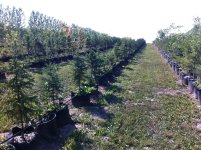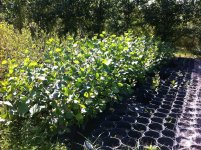going to push you over to
www.koiphen.com and then go into the "pond construction and filtration"
pipe boot = how to cut a hole in a liner. and shove a piece of pipe through it. and how to deal with pipe clamps so no holes / tears happen. for a water tight seal.
google keywords...
pipe boot site:
koiphen.com
then click up on images.
bottom drain = think shower drain, kitchen sink drain, bathroom sink drain, floor drain in a basement, etc...,etc.... there are a lot of DIY notations on koiphen for "DIY bottom drain". a bottom drain will be important to you. when it comes to clean all the CRUD that will build up in the bottom.
google keywords
bottom drain site:
koiphen.com
DIY bottom drain site:
koiphen.com
stand pipe = take a piece of pipe and barely sand down the outside of it, say 3 to 5 inches from one end. this is to make the pipe slip smoothly down into a fitting and bottom out inside the fitting (don't sand to much off). then take a dremal with a cutting disc. an put a grove around the pipe 1/2" to 2" from end you most likely want 2 groves total. these grove will hold a O-ring, the grove primarily to keep O-ring from slipping off of pipe. get a jar of vasaline of all things and lube down the part you sanded down and the O-ring. and you should get a nice water tight seal that can handle a couple feet or so of water. a "stand pipe" = a ON/OFF valve only. and the pipe must be vertical when it goes into a fitting. ((this is a DIY valve cheap and it works!))
google keywords
stand pipe site:
koiphen.com
you will have some issues. the most important one. any type of liner = SLICKER THAN SNOT! you will fall flat on your rear! it does not take much, for algae to start growing on liners. and when it does. you end up on hands and knees if not belly rolling across it. when things dry off and dry up. that is one thing. but other wise. WATCH IT! with you not keeping each area flood all the time and only for a couple hours at at time it should not be that big of an issue.
another issue. liners = holes, doesn't matter if it is PVC, EPDM, or like liners. you will be walking into the area a lot, and putting stuff down that might have a sharp edge more so the pots / baskets for all the plants. there are a lot of cheap liners out there. some better than others. i might push you towards EPDM type of liner. due to is more elastic / stretch more. vs say PVC liners that do not stretch as much. also go with a thicker liner if possible costs more. more likely to help things out long term in lasting to minor punctures.
for your sides... taking the dirt out and building a mini hill per say. for sides = BAD IDEA in my opinion. this is for a work area. not something to look at. this goes back to "falling flat on your rear" up above. having nice vertical sides or near vertical sides. can make it much easier getting in / out and safer overall. on the other hand. i will most likely suggest that you get treated lumber and sink them into the ground, with say only 1 to 2" inches sticking above the ground. and perhaps hammering in a bunch of rebar for stakes ever foot or so. going down into the ground = it should help keep the sides from bowing out on you to much. having your sides above ground = a lot more structural support. having sides 1 to 2 inches above ground = keeps run off water from rain from going into area. at same time gives you something to beat the weed eater against.
they sell liners generally by 5' feet width. and by 5' lengths. you can get custom cuts. but.... cost more. with you getting in and out of each area a lot. i might suggest something "narrow" using a 5' width liner. at how ever many feet you want. that way if it comes down to it. you can set your rear on the edge. and lean into the area. without risking walking across a slippery dangerous area, and work off of both sides.
going back to "top of this post of mine" you most likely looking at a "terrace" setup. or a "multi waterfall" stream like setup. were you fill the very top area with water. wait a couple hours. go over and pull a "stand pipe" that was inserted into a bottom drain... all that water empties out of the top unit, and flows down into the next area. wait a couple hours. so on, and so forth. your only issue will be having to pump water from the very bottom "pond per say" all the way back up to the very top unit.
with you driving tractors to vehicles right beside these ponds per say. i would suggest burying the pipe from the very bottom pond to the very top of the pond. directly below all of them. off to one side. that way you are not risking driving a vehicle over the pipe and crushing the pipe.
tools of the trade = "water level"
TIP: shower drains from local hardware stores can make for nice "bottom drains" in ponds that use liners and like. the issue is hunting for correct shower drain were you can easily use a "stand pipe". on koiphen you will find a lot of other ideas for DIY bottom drains / stand pipes.
TIP: you might consider using 8x8x16 inch concrete blocks as sides. there width might be a good thing. the only issue is them sinking over time into the ground.
TIP: if you due end up using 2 by ?? what ever size lumber. get a table saw and cut you some strips of 1x1's or something along them lines. fold the liner edge over the sides. and then place these strips of lumber over the liner. then use some screws and go through the strips, and through liner, into your sides. doing this = a clamp and holds the liner much better. and helps prevent rips of the liner. or portions of the liner ripping and falling back into the area. some folks have doubled or trippled up the liner were they put the strips of lumber. to help create a cushion, and help prevent any sort of splinters that might happen from poking the liner and causing a leak.
TIP: the very bottom pond, you might want to make out of concrete blocks with some re-enforcement in them. and put in a concrete bottom. this is more to deal with all the "mud" and "muck" that is going to come into your system. just from dealing with all the plants. look up "settling tanks" on koiphen basically a settling tank ( SC for short) lets all the muck settle into the bottom of the filter / tank. if you have a backhoe / mini excavator. or something along them lines. being able to let all the water from the ponds drain down into the very bottom pond. were you can get a little bit more carried away with a backhoe bucket. to scoop out the mud. might make your life much easier. at same time the very bottom tank can help reduce all the solids that the pump might pickup and plug up the pump. trying to re-use dirt water that will most likely be coming down from the ponds and trying to put it into irrigation system that is not built for "solids" can quickly clog up the irrigation system and all the little drip nozzles and spray heads. while a settling chamber does not remove all of it. it can reduce a good amount, and might be worth while to you.
google keywords...
settling chamber site:
koiphen.com
then click up on images.
there is a lot of folks on koiphen that re-use there fish pond waste (from the filters) to irrigate there lawns / trees / etc... normally this requrires enlarging holes in irrigation lines were water comes out. and using a "trash pump" a trash pump generally will have specs on it that states it can handle solids up to say 1/2" to 1" to say 3" in size without clogging. most of the time you will find a trash pump in local hardware stores in form of a submersible pump. there are a lot of pumps out there. but most of them can not handle solids / mud / muck very well and either the blades will get damaged quickly to they will simply clog up. hence notation of a "trash pump"
you might want to check out various "pre filters" i forget all the key words / DIY builds been a few years. the one's i remember right off = a settling chamber type of filter. and then a second smaller 10 to 55 gallon drum inside of the settling chamber tank. this smaller drum had various material in it. to help screen / filter out large stuff from twigs, to leaves, to fish poo, to other. and pending on filter material put into the smaller drum. much easier to clean and keep it from clogging up with stuff. ""and in that much easier for external pumps to be used"" other words not a submersible pump. with you putting lots of plants in the system.... clogs are going to come up.
TIP: trash pumps generally are not rated to run 24/7 and generally rated for utilty. other words only ran so long before they get a chance to shut off and cool down. the notation above about another filter inside the settling chamber. is more geared to any generic external pump. with more likely a "leaf basket pot" connected in line. so you can use what ever external pump you want to use. there are DIY leaf basket, to manufacture leaf basket pots. you will most likely something little bit bigger. to deal with all the crud that may be coming in. a good fitler setup = more expensive up front, but = lot cheaper long haul. and having to replace pump due to it got clogged up and burned up.
===============
i realize above is a lot about "ponds" but frankly that is what you are wanting and going to be end up using. just for a different thing. there are a lot of folks there on koiphen that have ponds dedicated just to "plants"

